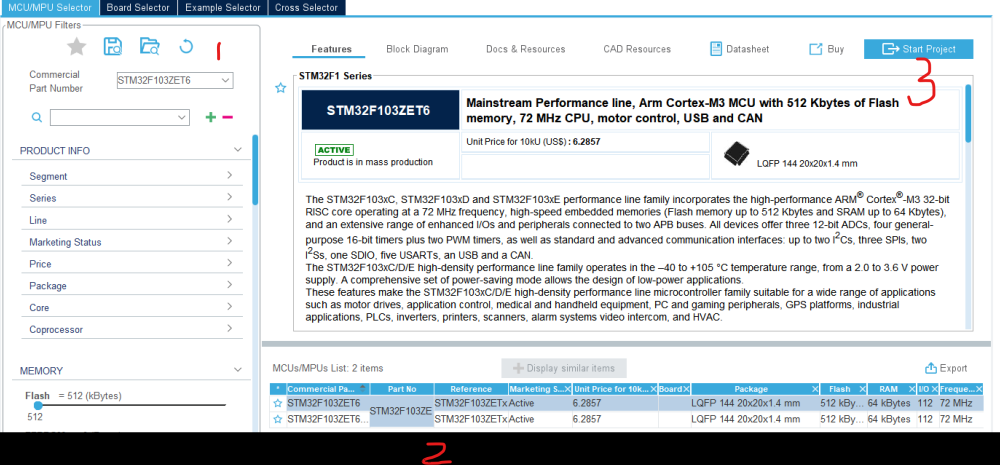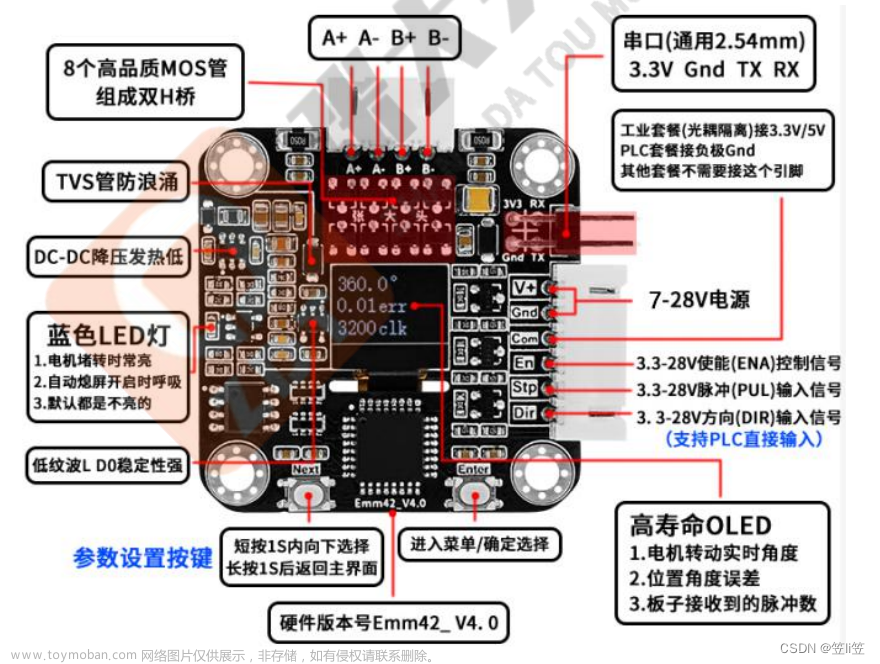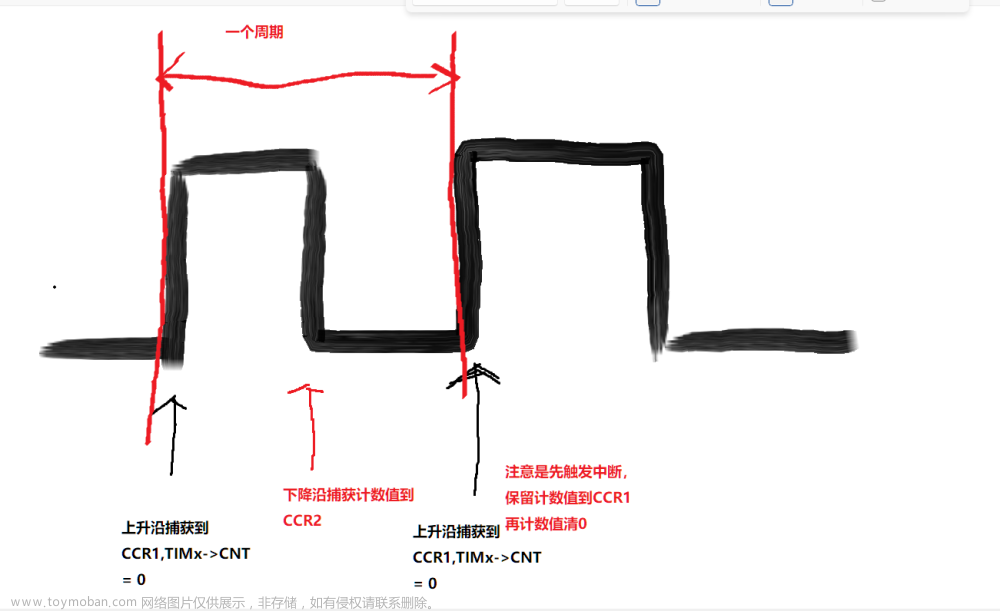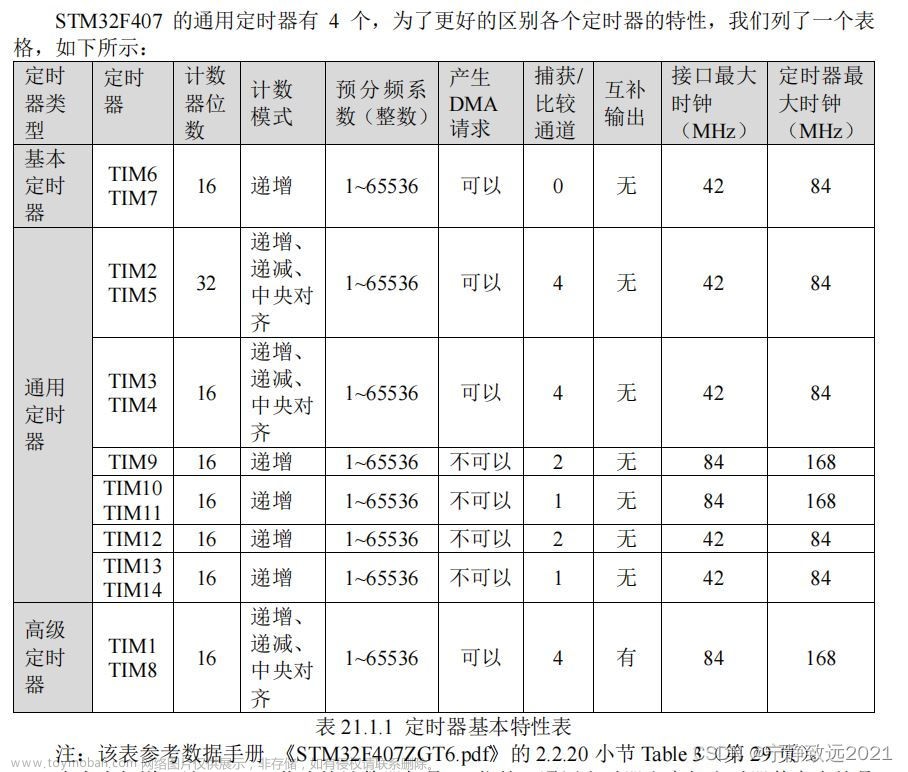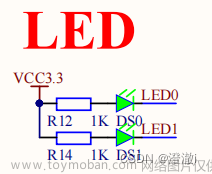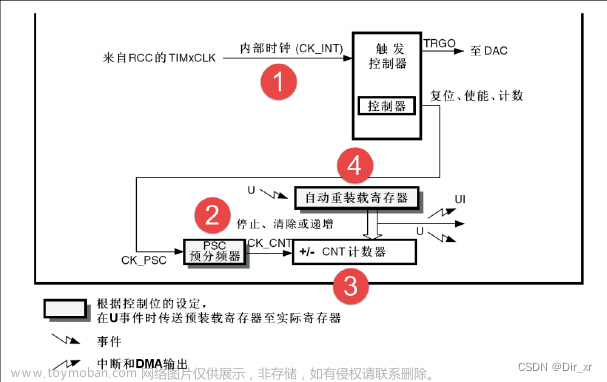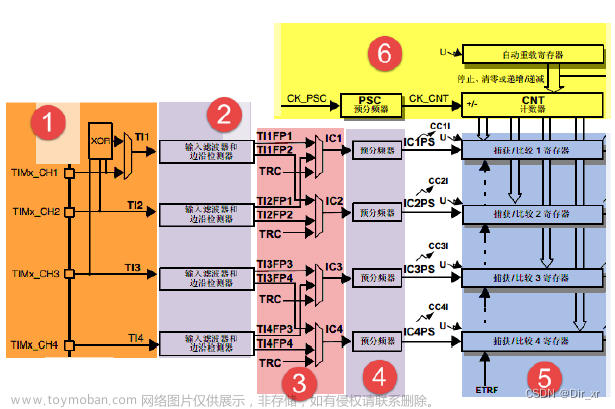基于STM32CubeIDE HAL库利用基本定时器实现串口接收不定长数据
- ✨申明:本文章仅发表在
CSDN网站,任何其他网见此内容均为盗链和爬取,请多多尊重和支持原创! - 🍁对于文中所提供的相关资源链接将作不定期更换。
- 📌相关参考《HAL库教程9:串口接收不定长数据》
🎉对于串口接收不定长数据的处理方案网上有很多,个人觉得采用定时器的方式最为简单,容易理解。文章来源地址https://www.toymoban.com/news/detail-700813.html
- 🎬串口数据收发演示:
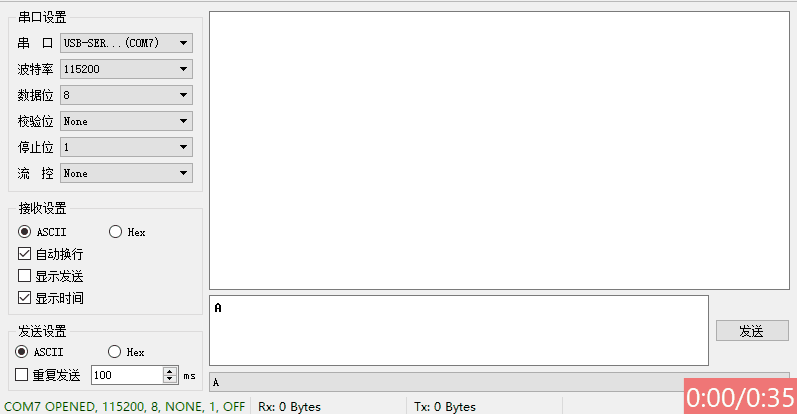
📑原理实现:就是利用串口接收中断,来开启对应的定时器计时,只要串口有数据进来就会进入串口接收中断函数里面执行相关内容,在接收中断函数里面,提供两种方式来处理计时方法,在一定时间内没有进入串口中断,那么定时器计时就会溢出,产生定时中断,来判断一次串口数据流的接收。
- ✨本示例基于
STM32G070RBT6单片机,64MHz频率。如果匹配到不同型号的单片机需要注意在配置定时器分频参数需要根据选定的单片机主频时钟来配置。
🛠在内置的STM32CubeMX配置
- 🌿基本定时器7配置如下:


🍁间隔的时间常常与通信的波特率是相关的。在9600波特率下,一个字节的数据共 起始+8数据+结束=10位,一位是104us,所以一个字节的数据是1.04ms,3.5个字节,我们就认为是4ms。有时可能有校验位,稍微保险一点,5ms吧。假如使用115200的波特率,5ms已经算是非常“奢侈”了。本文使用定时器7来计时,配置的PSC为63,ARR为4999,即5ms的溢出时间。这是按传输每一位数据来设定数据超时时间的,当然你也可以将串口接收中断作为定时器开始计时起点,然后定一个固定的时长来中断串口数据流的接收,具体看使用场合。
- 🔰如果串口接收数据频率比较高(数据流传输间隔小于500ms),那么就选择第一种方式按传输数据位来设定时长。
- 🔰如果串口接收数据频率不是很高(大于500ms),那么就选择一个固定的时长来中断串口数据流的接收。
- 🌴串口1配置
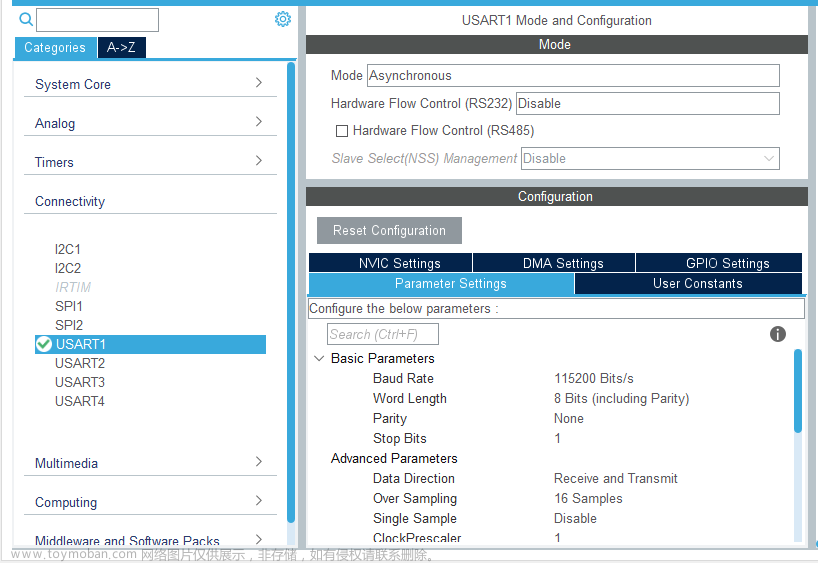

📝主程序代码
/* USER CODE BEGIN Header */
/**
******************************************************************************
* @file : main.c
* @brief : Main program body
******************************************************************************
* @attention
*
* Copyright (c) 2023 STMicroelectronics.
* All rights reserved.
*
* This software is licensed under terms that can be found in the LICENSE file
* in the root directory of this software component.
* If no LICENSE file comes with this software, it is provided AS-IS.
*
******************************************************************************
*/
/* USER CODE END Header */
/* Includes ------------------------------------------------------------------*/
#include "main.h"
#include "tim.h"
#include "usart.h"
#include "gpio.h"
/* Private includes ----------------------------------------------------------*/
/* USER CODE BEGIN Includes */
//#include <string.h> //包含memset清空数组函数(这里没有使用到)
/* USER CODE END Includes */
/* Private typedef -----------------------------------------------------------*/
/* USER CODE BEGIN PTD */
#define REC_LENGTH 20 //定义接收数据长度,根据使用需求自定义
uint8_t UART1_Rx_Buf[REC_LENGTH]; //接收数据存储
uint8_t UART1_Rx_flg=0; //定时器中断标志位
uint8_t UART1_Rx_cnt=0; //串口接收数据下标
uint8_t Rxbuff[1]; //串口接收数据缓冲
/* USER CODE END PTD */
/* Private define ------------------------------------------------------------*/
/* USER CODE BEGIN PD */
/* USER CODE END PD */
/* Private macro -------------------------------------------------------------*/
/* USER CODE BEGIN PM */
/* USER CODE END PM */
/* Private variables ---------------------------------------------------------*/
/* USER CODE BEGIN PV */
/* USER CODE END PV */
/* Private function prototypes -----------------------------------------------*/
void SystemClock_Config(void);
/* USER CODE BEGIN PFP */
/* USER CODE END PFP */
/* Private user code ---------------------------------------------------------*/
/* USER CODE BEGIN 0 */
/* USER CODE END 0 */
/**
* @brief The application entry point.
* @retval int
*/
int main(void)
{
/* USER CODE BEGIN 1 */
/* USER CODE END 1 */
/* MCU Configuration--------------------------------------------------------*/
/* Reset of all peripherals, Initializes the Flash interface and the Systick. */
HAL_Init();
/* USER CODE BEGIN Init */
/* USER CODE END Init */
/* Configure the system clock */
SystemClock_Config();
/* USER CODE BEGIN SysInit */
/* USER CODE END SysInit */
/* Initialize all configured peripherals */
MX_GPIO_Init();
MX_USART1_UART_Init();
MX_TIM7_Init();
/* USER CODE BEGIN 2 */
/* 初始化定时器7 */
// HAL_TIM_Base_Start_IT(&htim7);//可以不开启
HAL_UART_Receive_IT(&huart1, (uint8_t *)Rxbuff,1);//打开串口中断接收
/* USER CODE END 2 */
/* Infinite loop */
/* USER CODE BEGIN WHILE */
while (1)
{
/* USER CODE END WHILE */
/* USER CODE BEGIN 3 */
if(UART1_Rx_flg)//表示接收完成或超�??
{
HAL_UART_Transmit(&huart1,UART1_Rx_Buf,UART1_Rx_cnt,0xffff); //发�?�接收到的数�?????????
for(int i = 0;i<UART1_Rx_cnt;i++)
UART1_Rx_Buf[i] = 0;
UART1_Rx_cnt = 0;
UART1_Rx_flg = 0;
}
}
/* USER CODE END 3 */
}
/**
* @brief System Clock Configuration
* @retval None
*/
void SystemClock_Config(void)
{
RCC_OscInitTypeDef RCC_OscInitStruct = {0};
RCC_ClkInitTypeDef RCC_ClkInitStruct = {0};
/** Configure the main internal regulator output voltage
*/
HAL_PWREx_ControlVoltageScaling(PWR_REGULATOR_VOLTAGE_SCALE1);
/** Initializes the RCC Oscillators according to the specified parameters
* in the RCC_OscInitTypeDef structure.
*/
RCC_OscInitStruct.OscillatorType = RCC_OSCILLATORTYPE_HSE;
RCC_OscInitStruct.HSEState = RCC_HSE_ON;
RCC_OscInitStruct.PLL.PLLState = RCC_PLL_ON;
RCC_OscInitStruct.PLL.PLLSource = RCC_PLLSOURCE_HSE;
RCC_OscInitStruct.PLL.PLLM = RCC_PLLM_DIV1;
RCC_OscInitStruct.PLL.PLLN = 16;
RCC_OscInitStruct.PLL.PLLP = RCC_PLLP_DIV2;
RCC_OscInitStruct.PLL.PLLR = RCC_PLLR_DIV2;
if (HAL_RCC_OscConfig(&RCC_OscInitStruct) != HAL_OK)
{
Error_Handler();
}
/** Initializes the CPU, AHB and APB buses clocks
*/
RCC_ClkInitStruct.ClockType = RCC_CLOCKTYPE_HCLK|RCC_CLOCKTYPE_SYSCLK
|RCC_CLOCKTYPE_PCLK1;
RCC_ClkInitStruct.SYSCLKSource = RCC_SYSCLKSOURCE_PLLCLK;
RCC_ClkInitStruct.AHBCLKDivider = RCC_SYSCLK_DIV1;
RCC_ClkInitStruct.APB1CLKDivider = RCC_HCLK_DIV1;
if (HAL_RCC_ClockConfig(&RCC_ClkInitStruct, FLASH_LATENCY_2) != HAL_OK)
{
Error_Handler();
}
}
/* USER CODE BEGIN 4 */
void HAL_UART_RxCpltCallback(UART_HandleTypeDef *huart) //定义 USART1 接收完成回调函数功能
{
// if(huart->Instance==USART1)
// {
// __HAL_TIM_SET_COUNTER(&htim7,0);//定时器清
/* Read data from the RX data register */
// HAL_UART_Receive_IT(&huart1,(uint8_t *)Rxbuff,1);//每接收一个数据,就打1次串口中断接收,否则只会接收1个数据就停止接收
if(0 == UART1_Rx_cnt)
{
__HAL_TIM_CLEAR_FLAG(&htim7,TIM_FLAG_UPDATE);
HAL_TIM_Base_Start_IT(&htim7);//�?启定�?
}
__HAL_TIM_SET_COUNTER(&htim7,0);//清空计数�?
UART1_Rx_Buf[UART1_Rx_cnt] = Rxbuff[0];
UART1_Rx_cnt++;
HAL_UART_Receive_IT(&huart1,Rxbuff,1);
}
void HAL_TIM_PeriodElapsedCallback(TIM_HandleTypeDef *htim)
{
if(htim==(&htim7))
{
UART1_Rx_flg = 1;
HAL_TIM_Base_Stop_IT(&htim7);//关闭定时
}
HAL_GPIO_TogglePin(GPIOC,GPIO_PIN_13);
}
/* USER CODE END 4 */
/**
* @brief This function is executed in case of error occurrence.
* @retval None
*/
void Error_Handler(void)
{
/* USER CODE BEGIN Error_Handler_Debug */
/* User can add his own implementation to report the HAL error return state */
__disable_irq();
while (1)
{
}
/* USER CODE END Error_Handler_Debug */
}
#ifdef USE_FULL_ASSERT
/**
* @brief Reports the name of the source file and the source line number
* where the assert_param error has occurred.
* @param file: pointer to the source file name
* @param line: assert_param error line source number
* @retval None
*/
void assert_failed(uint8_t *file, uint32_t line)
{
/* USER CODE BEGIN 6 */
/* User can add his own implementation to report the file name and line number,
ex: printf("Wrong parameters value: file %s on line %d\r\n", file, line) */
/* USER CODE END 6 */
}
#endif /* USE_FULL_ASSERT */
📚程序源码
- ✨申明:本文章仅发表在
CSDN网站,任何其他网见此内容均为盗链和爬取,请多多尊重和支持原创! - 🍁对于文中所提供的相关资源链接将作不定期更换。
链接: https://pan.baidu.com/s/11K9jzCrRAkC18RKtvoS_CQ
提取码: rhrp
文章来源:https://www.toymoban.com/news/detail-700813.html
到了这里,关于基于STM32CubeIDE HAL库利用基本定时器实现串口接收不定长数据的文章就介绍完了。如果您还想了解更多内容,请在右上角搜索TOY模板网以前的文章或继续浏览下面的相关文章,希望大家以后多多支持TOY模板网!



